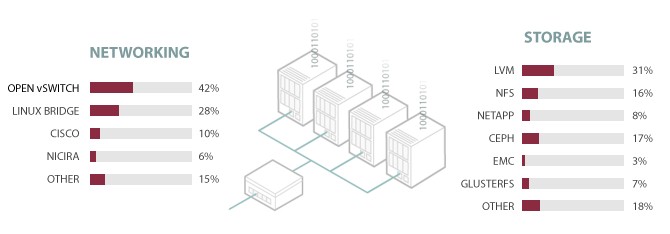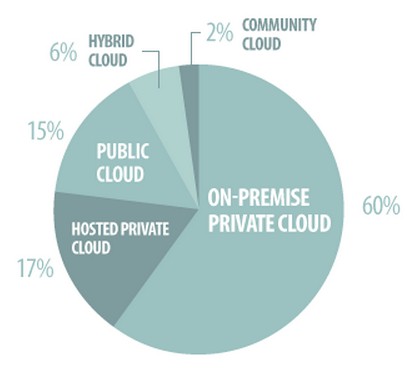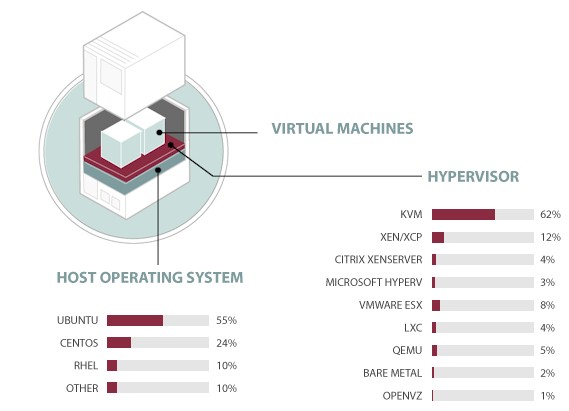Who Is Using OpenStack, And How?

The OpenStack Summit is underway in Hong Kong this week, and the foundation behind the cloud controller project has released the results of a survey that was done to try to figure out just who is putting OpenStack into production and how it is being used.
The survey was done in October not only to take the pulse of the user base, but also to seek input from those users concerning the "Icehouse" release of OpenStack, which is due next April. The summit's purpose, in fact, is to bring the key contributors to the OpenStack project together to hash out the Icehouse feature set.
As you might expect, a big portion of the OpenStack installed base is in the United States and Western Europe, but the software is equally popular (in terms of the number of production installations) in China and India. Remember that this data is not quantifying the absolute installed base of OpenStack, but is just a sample of customers – cloud builders, service providers, government agencies, and private enterprises – who took the OpenStack Foundation survey. They had 178 proof of concept clusters, 173 software development and QA clusters, and 165 production clusters running applications of various kinds.
As you can see from the pie chart, the majority of the OpenStack installations are for private clouds, with a chunk of them being inside an organization's own datacenter and a chunk being managed in a hosted environment by a third party. Only about 15 percent of installations are for public clouds, and another 6 percent are for hybrid clouds that mix public and private instances.
Companies in the IT sector are among the top deployers of OpenStack, which stands to reason. Academic and research institutions are not far behind, and behind them are telecommunications companies. Together, these organizations have some of the largest infrastructure in the world, and they accounted for 80 percent of OpenStack installations in this survey. Government and defense contractors, manufacturers, retailers, healthcare providers, and financial services firms are trailing, and have only a few percent share at this point. But that will change.
The distribution by company size has some small shops and some very large enterprises. About a quarter of those with OpenStack installed has 20 or fewer employees, and about a fifth has more than 10,000. About a third has between 21 and 500 employees.
The top business drivers behind the adoption of OpenStack cited by those using it in production are saving money, by which we presume is meant not using VMware's vCloud instead of OpenStack as well as making more efficient use of servers and storage that have been virtualized. Operational efficiency was cited as the number two reason for using OpenStack, in fact, but this always comes back to money. The fact that OpenStack is an open platform was the third most cited reason for choosing this cloud controller, and the fourth was the flexibility in choice for the technology underneath OpenStack. The ability to innovate and compete on top of OpenStack was another reason organizations say they chose this platform compared to alternatives from VMware, Microsoft, Citrix Systems, and others.
The number one use for OpenStack was as the foundation for web services applications, followed up by software quality assurance and testing. Running virtualized databases was the third most cited application running atop OpenStack, oddly enough, followed by basic research, then continuous integration and automated testing. Using OpenStack as a storage and backup platform was number six on the list, followed by virtual desktop infrastructure and then the mish-mash of data mining/Hadoop/big data. Putting OpenStack in charge of traditional HPC clusters rounded out the list.
OpenStack supports a number of different hypervisors and virtual machines, but at this point, KVM is by far the most popular hypervisor and the Ubuntu Server distribution of Linux from Canonical and the CentOS clone of Red Hat Enterprise Linux are the most popular operating systems deployed on OpenStack.
Similarly, there are a number of different ways to wire networks and storage into OpenStack, and here is how the network drivers and storage drivers break down in the installed base:
 The production OpenStack clusters out there are still pretty modest in terms of size, but there are some biggies. Of those organizations that reported their cluster size – many did not – the vast majority had under 50 nodes and under 500 cores. There were 11 OpenStack clusters with more than 1,000 nodes and 10 with more than 10,000 cores under management, and a couple dozen clusters between these two extremes. Generally, a core is a virtual machine instance on these clouds, with some slight variation.
The production OpenStack clusters out there are still pretty modest in terms of size, but there are some biggies. Of those organizations that reported their cluster size – many did not – the vast majority had under 50 nodes and under 500 cores. There were 11 OpenStack clusters with more than 1,000 nodes and 10 with more than 10,000 cores under management, and a couple dozen clusters between these two extremes. Generally, a core is a virtual machine instance on these clouds, with some slight variation.
The size of block storage is still fairly modest on these production clusters, and that makes sense given the size of the clouds. Most shops in the survey having under 100 TB of block storage. Ditto for object storage. Most production OpenStack clouds have fewer than 10,000 objects in their Swift, Ceph, or other object stores. There is one that has more than 500 million objects, and three that have over 100 million, however.
Interestingly, at this point, the private OpenStack clouds are smaller than the public ones. If this is the case, then it is absolutely clear that Rackspace Hosting, one of the founders of the OpenStack project and its largest user, did not take the survey.
Over time, there is little doubt that OpenStack clusters will grow to enormous size. As EnterpriseTech reported when the current "Havana" release came out in October, the current OpenStack is nowhere near its original scalability design goals, set out by project founders NASA and Rackspace, more than three years ago. They want to be able to build a cloud that can have up to 1 million nodes under management with up to 60 million virtual machines. Rackspace has tens of thousands of servers under management by OpenStack, and BlueHost has 20,000 nodes. These latter firms are pushing the boundaries, but most enterprises will not be anywhere near them for some time.












